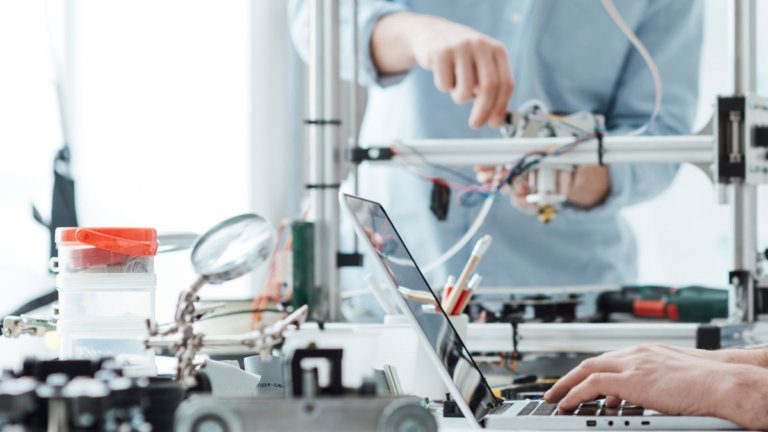Innovation
1+1=100: CableLabs’ University Research Relationships and Their Role Within the Innovation Ecosystem

One of CableLabs’ most important objectives is the continuous pursuit of new ideas that can lead to game-changing innovations for the cable industry. CableLabs university research relationships give us access to great minds around the world that can bring innovative ideas to the cable industry and supercharge our own efforts at CableLabs. It’s also an opportunity to build long-term, mutually beneficial working relationships with some of the best research labs in the country.
When you think of building the future, a university lab, traditionally considered a goldmine for radical thinking and innovative research, is a natural place to start. Some of the best academic institutions in the U.S., such as Georgia Tech, Carnegie Mellon, Princeton and our neighbor, Colorado State, share our vision of a highly-connected near future and are doing amazing research in networking, 5G, cybersecurity and other areas of interest to the cable industry. Our partnerships with these institutions have already proven to be a worthwhile investment producing innovative solutions that are helping drive our progress in IoT security and mobile networking.
CableLabs + Universities: Building the Future Together
Current innovation projections for the near future, including the proliferation of IoT devices, VR/AR applications, artificial intelligence and seamless mobile communication, all require a powerful broadband network. Together with our university partners, we’re developing ideas that’ll bring us closer to the multi-Gigabit network reality of the future. Let’s take a look at some examples of how we work together to make it happen.
- Future Mobile Infrastructure
In just 20 years we’ve migrated from basic flip phones to powerful multi-use smartphones that are essentially our pocket-sized lifeline to everyone and everything we need. Not only do we have better hardware, but our mobile networks have also been enhanced to keep up with the exponentially growing user demand. But what will our hyperconnected future look like years from now? How will our mobile networks deal with massive amounts of data? Does our current mobile infrastructure require radical changes? Our partners at Carnegie Mellon University’s Electric & Computer Engineering Department are working on answering these questions by taking a fresh look at Mobile Core Network Architecture and the implications of building and operating future mega-powerful mobile networks.
- The Future of IoT & Network Security
Our users’ desire for increased connectivity and productivity has already led to the proliferation of various IoT sensors and devices in our homes, cars, offices and everywhere in between. In response, companies are rushing to meet user demand by selling products without adequate cybersecurity measures. Since smart technology is only going to become more prevalent in the near future, this hacker’s dream is becoming an industry-wide problem that needs urgent attention. We’ve been working with the Center for Information Technology Policy at Princeton to understand IoT device behavior and potential issues. We’ve also been working closely with the faculty and graduate students at Colorado State University to develop new ways of identifying problems and protecting against security threats. This work will help inform CableLabs’ larger effort to drive better IoT security standards across the industry. In addition to addressing IoT issues, Colorado State is also exploring ways of using real-time network data to identify unusual traffic patterns and applying multiple strategies to mitigate the rapidly evolving denial of service attacks.
- 5G and Fiber-Wireless Integration
4G wireless networks are fast but not nearly fast enough for the low-latency technologies of tomorrow. The 5G rollout in the next few years will introduce multi-Gbps mobile broadband speed and along with it—a new era in connectivity. 5G can support cutting-edge technologies, like VR, AI and IoT devices in large quantities, opening the door to a plethora of exciting new inventions, like self-driving AI-powered cars and much more. Together with our research partners at Georgia Tech, we’re exploring the possibilities of the 5G network and are looking into expanding the bandwidth capacity of cable’s optical technologies to meet the demand of 5G devices.
Moving forward, we will continue seeking out extraordinary thinkers within the academic community and supporting the development of new ideas and talent—the two main ingredients for a brighter future.
Innovation
Furthering CableLabs’ Innovation Mission through University Research


Our focus on bringing game-changing innovations to the cable industry has never been greater. But how does a relatively small organization like CableLabs create the capability to consistently bring about great innovations? The answer has to include leveraging of external relationships. Only in partnership with others will we be able to multiply our efforts and deliver on our innovation mission. The UpRamp program and our emerging co-innovation efforts (watch for our forthcoming blog post) are important vehicles to engage budding and established commercial enterprises. To complement these efforts and gain additional perspective, CableLabs is increasing its engagement with university research.
Engaging deeply with university research is relatively new for CableLabs. For the last couple of years, we have set aside a small amount of resources to contribute to research in areas of interest. We have kept the scope of our initiatives modest as we explored both new areas and new relationships. Our objective was to plug into existing research efforts, building upon established interests and resources.
The impact of these initial forays is encouraging:
- Some underpinnings of our current Full Duplex DOCSIS innovation efforts have their roots in research done at Stanford University’s ON.lab, an early participant in university research program.
- Relationships we have built at the University of Georgia and the University of North Carolina have allowed us to gain greater insights into broadband usage and how changing behaviors may impact access network evolution.
- Work with the University of Colorado has played a key role in better understanding wireless spectrum issues and helped set that stage for opening of more Wi-Fi spectrum, which was a major win for Wi-Fi users in the US. Our continued work with the university is helping us gain more insight into new spectrum opportunities.
- Work with Colorado State University has been developing new capabilities in network security. CableLabs has specifically supported development of new ways to support rapid response by service providers by monitoring network routing information in real time.
How do we build on our efforts?
As we continue to refine our approach to university engagement, we are focused on a few key characteristics that we think can increase our odds of impactful outcomes. At its core, we are seeking out researchers with interests and objectives that complement our own initiatives. Without this foundation, it’s unlikely to get either the university or CableLabs’ teams to invest the time required to build and maintain effective working level relationships.
Much more than any funding provided, we think that investment in time and interaction is critical. Only by investing our time in building relationships and trust can we have a healthy two-way exchange of ideas. Of course, Cablelabs is hoping to leverage insights from researchers, but we also want researchers to consider Cablelabs as a partner that can provide cable industry perspective, targeted interaction with cable industry players, and collaboration in the research itself. While much of our university research activities take place in the context of a specific project, we need to keep an eye on not just the project level, but in how the project contributes to building a broader and deeper relationship over time.
At CableLabs, our goal is to bring new innovation to the cable ecosystem. By growing and deepening our university relationships we can improve our own effort and help guide others. If done right, the result can pay dividends for years to come, creating a more powerful and robust innovation flow for the cable industry.



